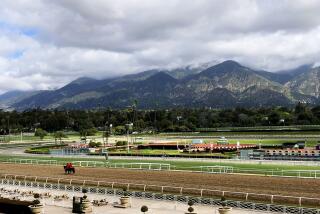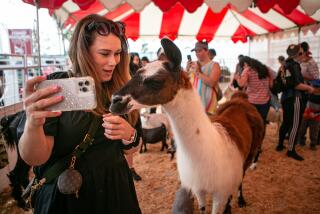A Fair Deal for Fair’s Business Sponsors : 120 Local, National Firms Using Event as Sales, Advertising Device
- Share via
E.F. Hutton is planning to make a very short-term investment in the stock market next week. And it won’t mind eating its investment.
That’s because the brokerage house plans to spend up to $3,000 on blue-ribbon commodities--pigs and sheep--at the 1987 Orange County Fair. The bullish investment is good promotion. Hutton is one of about 120 local and national firms that use the annual fair as an advertising and sales device.
With potential attendance this year of 500,000, the 11-day fair offers companies a way to get their names and pitches to a sizable cross section of affluent Orange County. In return, the fair will receive more than $200,000 in cash, services and tit-for-tat “trade-outs”--with businesses that supply products or advertising in exchange for space at the fairgrounds and the linking of their names with the Orange County Fair.
The biggest investors are the 55 sponsors that have chipped in anything from a trophy to $60,000 in cash and services for the privilege of backing the fair. This year, a record 27 sponsors have contributed more than $1,000 each--including, for instance, the California Egg Commission, which gave $8,500 worth of food, services and cash, a giant promotional egg carton and 15,000 contest-destined eggs.
An additional 65 companies--among them E.F. Hutton’s Costa Mesa office--paid up to $8.50 per pound for pigs, cows and sheep at the Junior Livestock Auction. “It’s an intangible benefit,” said George Rach, the resident manager who was host to a company pig roast after E.F. Hutton’s $2,040 winning bid last year.
“We want to project an image that E.F. Hutton is willing to share its good fortune with people who don’t have that ability.”
Besides being good public relations, supporting fairs has become big business.
Nationally, more than 3,000 corporations will spend more than $1 billion this year on sponsoring fairs, festivals and sporting events--triple what was spent three years ago, according to Special Events Report, a Chicago-based newsletter that tracks sponsorships.
When Orange County’s fair began offering sponsorships five years ago, it collected $10,000 from four sponsors. Now it gets 10-15 new inquiries from potential backers each year, according to Jill Ann Lloyd, the media coordinator who is already lining up sponsors for the 1988 fair.
Some of that growth can be traced to the 1984 Olympics, which were largely funded by sponsors.
And once companies are interested, fairs are attractive because they are a comparatively cheap way to showcase brand names or products that can’t be mass-mailed in sample sizes. “Sponsors love them because they’re a fun event and people have a positive association with your product,” said Susan Travers, spokeswoman for the Western Fairs Assn. in Sacramento.
For Coors beer--which this year contributed $20,000 for such perks as its name on the “Coors grandstand arena”--the fair means product exposure. Vendors, not sponsors, decide what brands are sold (and Coors will be on sale, about 1,200 kegs of it), but the contribution got Coors’ name on the rodeo grandstand in a nice tie-in with the company image, marketing manager Barbara Belcher said in Tustin.
While she admitted that “it’s pretty hard to measure” the payoff in sales, “the exposure of having our name out there within the county is very important.”
The California Egg Commission is using the fair to give away omelets and cholesterol tests in hope of encouraging fair goers to eat more eggs.
“We’re losing our fanny” on the $2 tests, commission President Robert D. Pierre said, “but we’re cognizant that something has to be done” to win over more egg eaters. “This is the best exposure we can get.”
The Ritz restaurant in Newport, on the other hand, has another idea. For several years it has donated a free dinner for four as a prize to the tray-toting waiter or waitress who best navigates a contest obstacle course. “Who knows? Some of those people can come apply for a job at the Ritz someday,” said Jackie Murrill, special occasions manager.
For others, the benefits are much more direct.
47-Foot Boat Brought In
About 300 companies have rented booths where they can show off their wares and hand out such goodies as promotional tote bags, suntan lotion or swigs of their product. The goods range from slicer-dicers to kitchen cabinets.
The right type of product can sell better than hot cakes. Seven Crown Resorts, for example, which rents houseboats for vacations, invested about $30,000 to bring a 47-foot houseboat to the fair. The La Habra company expects to make $30,000 to $40,000 in profits in the next year from the 100 or so bookings that should result from fair-goers who may never before have seen a houseboat, marketing director Marie Curren said.
Of course, sometimes even the best-laid promotions can flop. That was exactly what happened with King Kong a couple years ago, when somebody popped a 10-story, inflatable gorilla that one company used as a fair promotion. Kong nearly slumped over Newport Boulevard before he was patched.
Last year, another sort of disaster struck when Albertson’s found stacks of its promotional tickets for free fair admission being scalped in the fair’s parking lot. Some of the tickets were stolen, a company spokesman said, and others apparently were carelessly distributed by the handful, fair officials said.
Still, Albertson’s sees the fair as a “good advertising program” and may participate again, according to Carl Pennington, divisional vice president.
Most company marketing executives, in fact, believe the fair is a good enough opportunity that anything should be considered--almost.
“Buying a steer?. I hope not. I’ve got a very small backyard,” Coors’ Belcher said.
More to Read
Inside the business of entertainment
The Wide Shot brings you news, analysis and insights on everything from streaming wars to production — and what it all means for the future.
You may occasionally receive promotional content from the Los Angeles Times.









